-
News & Events

From October 20 to 24, Professor Bähr, a Fellow of German National Academy of Sciences Leopoldina, Director of the Dept. of Neurology of the University Medical Center of Göttingen, and Director of the Heart & Brain Center Göttingen, was invited to visit the Neurological Diagnosis and Treatment Center of Wuxi People's Hospital for a five-day academic exchange as a visiting professor. This cross-border academic interaction, featuring multi-dimensional and in-depth exchanges, injected internationally cutting-edge diagnosis and treatment concepts as well as scientific research ideas into the hospital, and built a solid bridge for Sino-German cooperation in neurology.
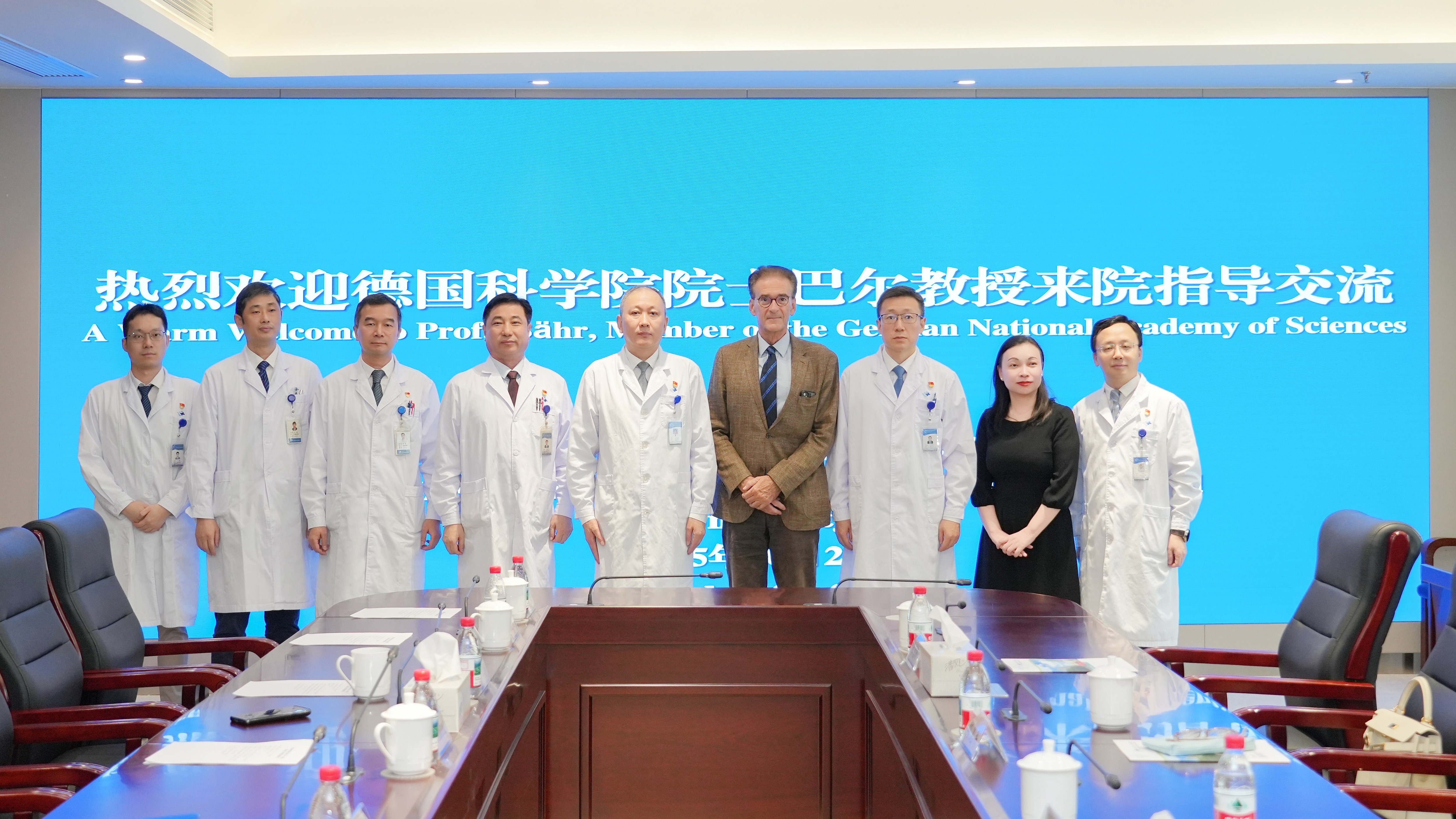
The leaders of the hospital and the core team members of Neurology attached great importance to Prof. Bähr’s visit and held a warm welcome ceremony for him. President GU Xiaofeng delivered a speech for the academic exchange and invited Prof. Bähr to watch the promotional video of the hospital. Party Secretary GAO Yufeng introduced the overall situation of the hospital to Prof. Bähr and presented him with souvenirs featuring Chinese cultural characteristics. In addition, the team of the hospital and Prof. Bähr jointly inaugurated the "Sino-German Exchange Center for Neurological Disease Diagnosis and Treatment," and President GU Xiaofeng awarded him the appointment letter as an international visiting professor. Subsequently, Prof. Bähr gave a keynote lecture on specialty construction.

The five-day exchange was comprehensive and fruitful. In terms of clinical diagnosis and treatment, Prof. Bähr conducted discussions on multiple difficult cases with the team of the Neurological Diagnosis and Treatment Center, covering various diseases. He made in-depth ward rounds for consultations and examinations, put forward precise suggestions on key issues such as diagnosis and treatment plans, treatment timing, and surgical target selection. He also conducted physical examinations for patients at the outpatient clinic and formulated personalized treatment plans. In the teaching session, Prof. Bähr delivered several special lectures including "Functional Neuroanatomy."
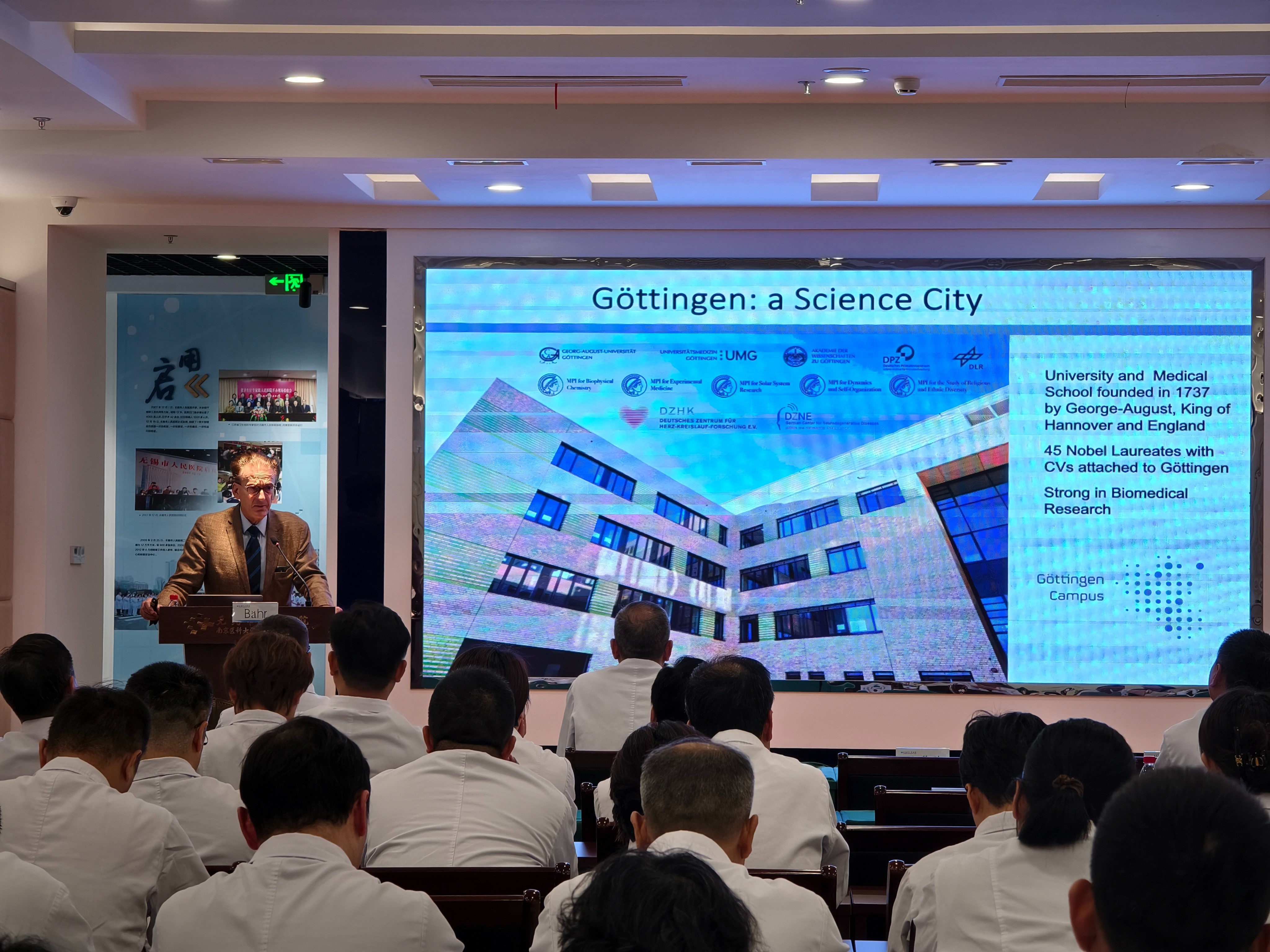
In terms of scientific research and specialty development, Prof. Bähr shared the experience of integrated medical, teaching, and research development at the Heart and Brain Center Göttingen, as well as the local scientific research ecosystem. Young researchers from the Neurological Diagnosis and Treatment Center reported on several research projects, which received acknowledgement from Prof. Bähr. He fully affirmed the scientific research strength of the center, saying that "these studies completed by a group of doctors who are primarily engaged in clinical work are very impressive."

The local doctors found the exchange to be extremely meaningful. The Neurological Diagnosis and Treatment Center reported that the cutting-edge concepts, technologies, and analysis of difficult case diagnosis and treatment strategies shared by Prof. Bähr provided important practical references for clinical work. His systematic explanation of the stroke diagnosis and treatment process offered a clear template for the standardized construction of the stroke center of the hospital, and his precise guidance on scientific research pointed out new directions.

At the end of the event, the team of the hospital expressed sincere gratitude and expectations to Prof. Bähr, welcoming him to visit Wuxi People's Hospital again in the future for guidance. They also pledged to integrate his suggestions to improve relevant diagnosis and treatment technologies. This academic exchange not only enabled the Neurological Diagnosis and Treatment Center to accurately introduce internationally advanced concepts and technologies, enhancing the precision of clinical diagnosis and treatment as well as scientific research capabilities, but also built an international specialty development ecosystem, laying a solid foundation for deepening long-term Sino-German cooperation in neurology and jointly promoting progress in this field.
Welcome Ceremony
On the morning of October 20, Wuxi People's Hospital held a warm welcome ceremony for Prof. Bähr, attended by the leaders of the hospital and the core team members of Neurology. President GU Xiaofeng delivered a speech for the academic exchange and specially prepared a promotional video of Wuxi People's Hospital for Prof. Bähr. Subsequently, Party Secretary GAO Yufeng of Wuxi People's Hospital introduced the overall situation of the hospital to Prof. Bähr.

GAO Yufeng, Party Secretary of Wuxi People's Hospital
Prof. Bähr also introduced the University Medical Center of Göttingen. The University of Göttingen and its medical school are world-renowned cradles of Nobel laureates, having nurtured 45 Nobel Prize winners to date. Founded by King George II of Great Britain in 1737, the university has laid a solid academic foundation, especially in biomedical research. The center has 130 professors, 3,700 students, and 7,900 employees. Its annual care turnover reaches 840 million euros, with 640 million euros in the state funding and an additional 60 million euros in third-party research funding. The University Medical Center of Göttingen is one of only two maximum-care providers within an 80-kilometer radius, serving a population of 3.2 million.
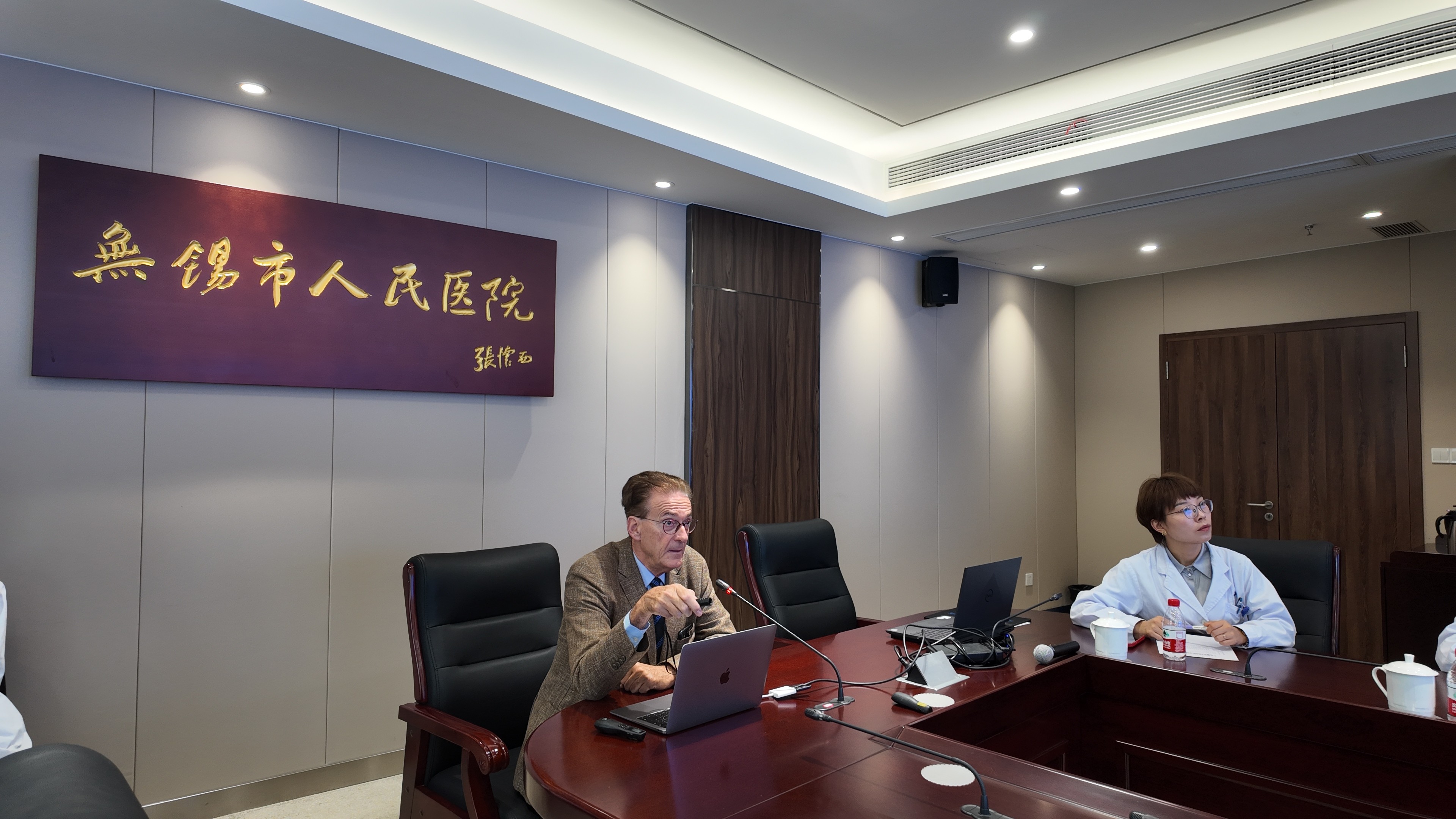
At the end of the ceremony, Party Secretary GAO Yufeng presented special souvenirs to Prof. Bähr, and both parties took group photos as a memento.

After the welcome ceremony, accompanied by Prof. SHAO Junfei, Director of the Neurological Diagnosis and Treatment Center, and other team members, Prof. Bähr visited relevant facilities including the Neurological Diagnosis and Treatment Center, the wards of Neurology and Neurosurgery and the central laboratory, and the Wuxi Medical Center of Nanjing Medical University. He also exchanged views with the hospital on issues such as centralized patient monitoring in the stroke unit and undergraduate, master’s, and doctoral student education.

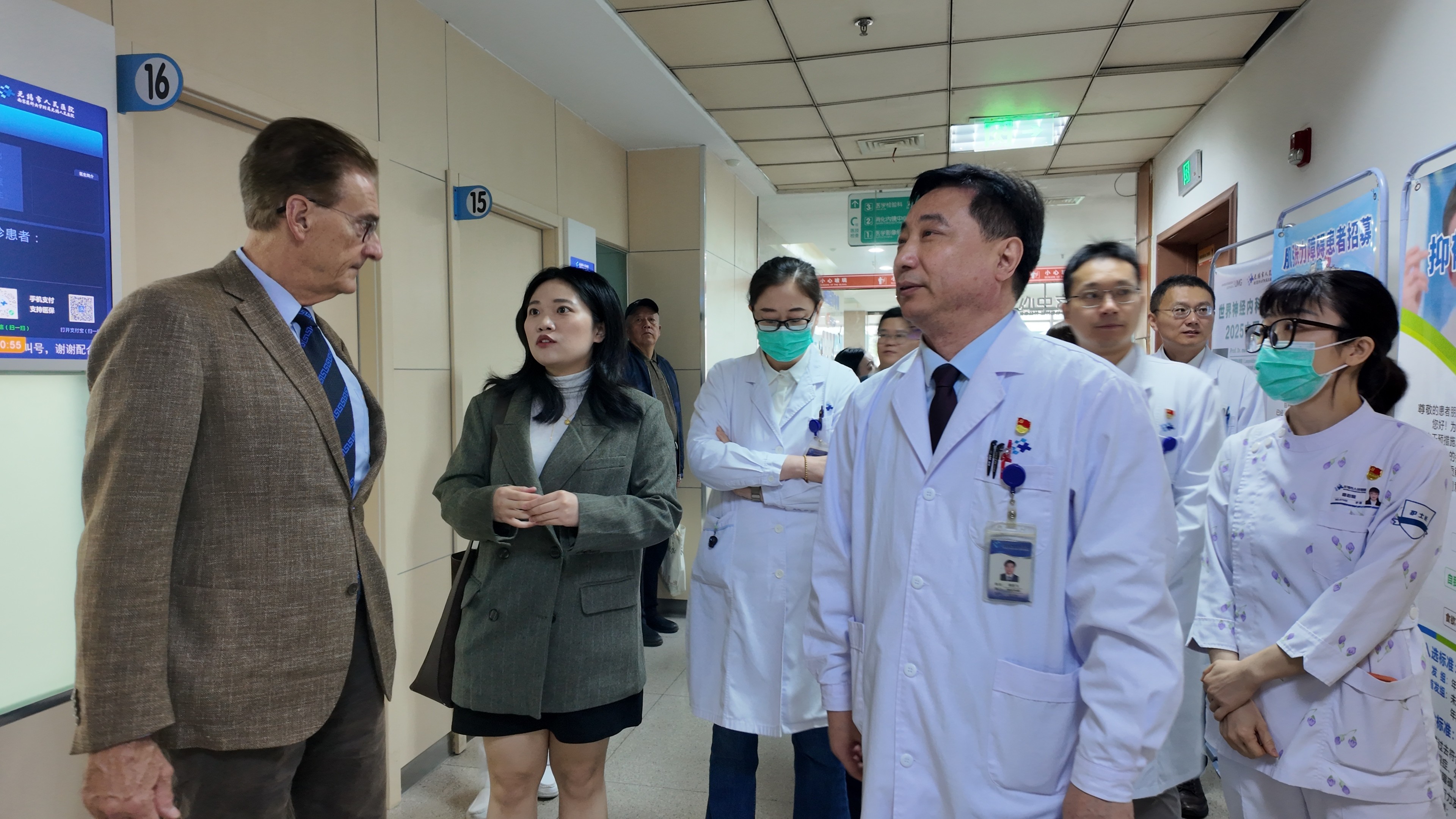
In the afternoon, Prof. SHAO Junfei gave a detailed introduction to the hospital and the Neurological Diagnosis and Treatment Center to Prof. Bähr. Subsequently, JI Wei, Assistant Director of the Neurological Diagnosis and Treatment Center, reported a case of cerebral venous sinus thrombosis. Accompanied by the team, Prof. Bähr went to the ward to examine the patient. After the consultation, both parties conducted in-depth discussions on the patient’s diagnosis and treatment plan and ideas. They also analyzed differences in the incidence, etiology, and treatment strategies of cerebral venous sinus thrombosis between China and Germany. The on-site discussion was lively, and the local doctors said they gained great inspiration and benefits.

Both parties expressed full expectations for the upcoming academic exchange activities, believing that they could learn more cutting-edge concepts and advanced experiences from each other and jointly promote the development of neurology in China and Germany.
Difficult Case Discussions
On the morning of October 21, the team of the Neurological Diagnosis and Treatment Center reported three cases to Prof. Bähr and conducted detailed discussions on key clinical issues. The first case was Neuromyelitis Optica Spectrum Disorder (NMOSD). Both parties held in-depth discussions on topics such as the selection of sequential treatment plans for preventing recurrence, the applicability of different plans, the significance of AQP4 antibody titer levels in evaluating disease stability, the importance of selecting sequential treatment plans, factors affecting patient prognosis, and how to effectively monitor disease changes during recurrence prevention.
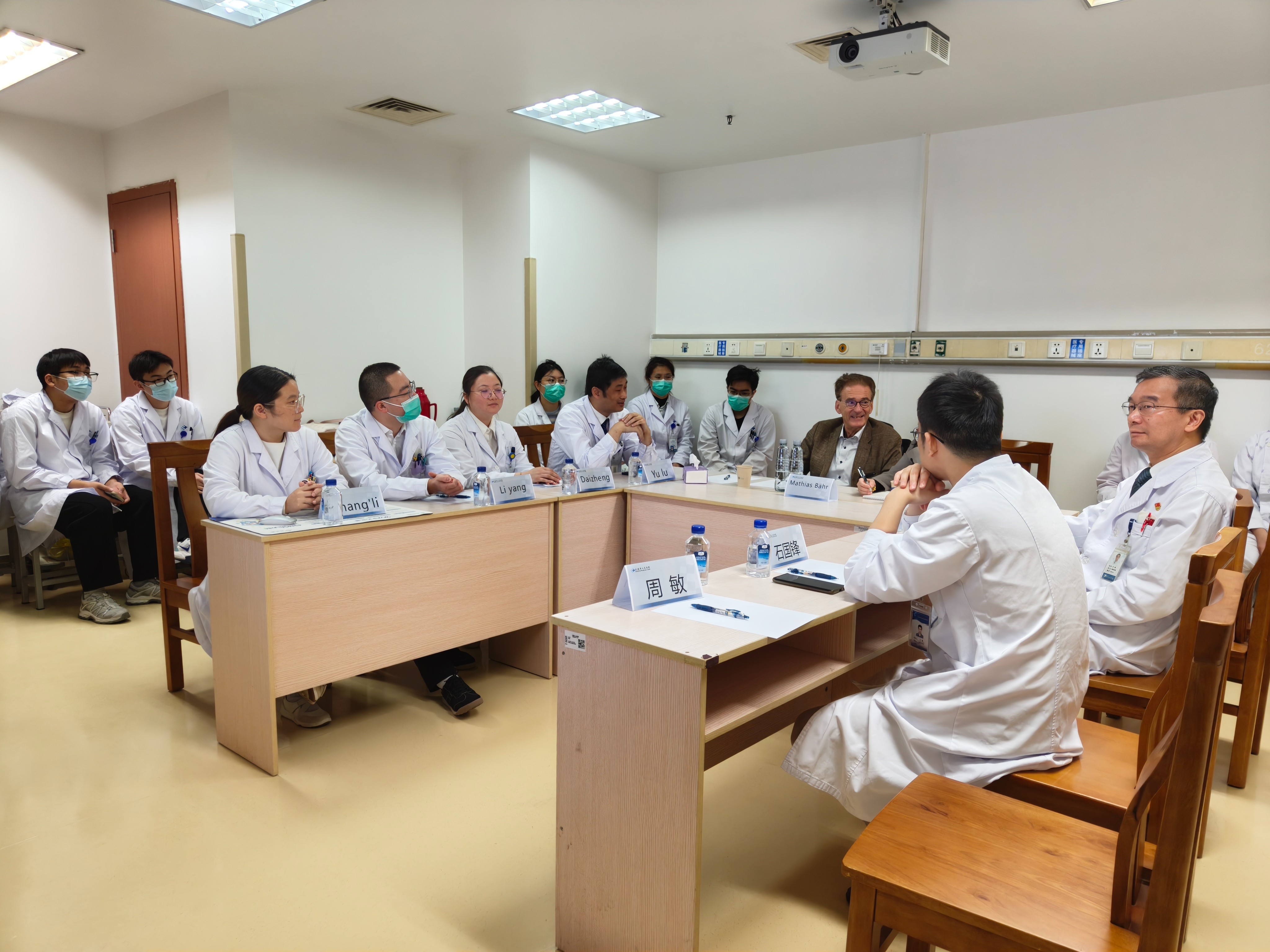
The second case was a sharing on Endovascular Treatment for Chronic Internal Carotid Artery Occlusion with Cerebral Infarction. The patient had refused emergency interventional treatment during a previous visit to another hospital and had obvious hemiplegia before surgery. The key points of discussion included whether the timing of elective interventional treatment was appropriate, whether rehabilitation treatment should be prioritized, and the considerations for elective interventional treatment after waiting several weeks.

The third case was a report on anti-GABAGR Encephalitis. Both parties conducted in-depth discussions on three core issues: etiological identification of psychiatric symptoms, long-term immunotherapy plans, and precautions during follow-up. After the reports, team members of the Neurological Diagnosis and Treatment Center and Prof. Bähr took group photos to record this meaningful exchange activity.
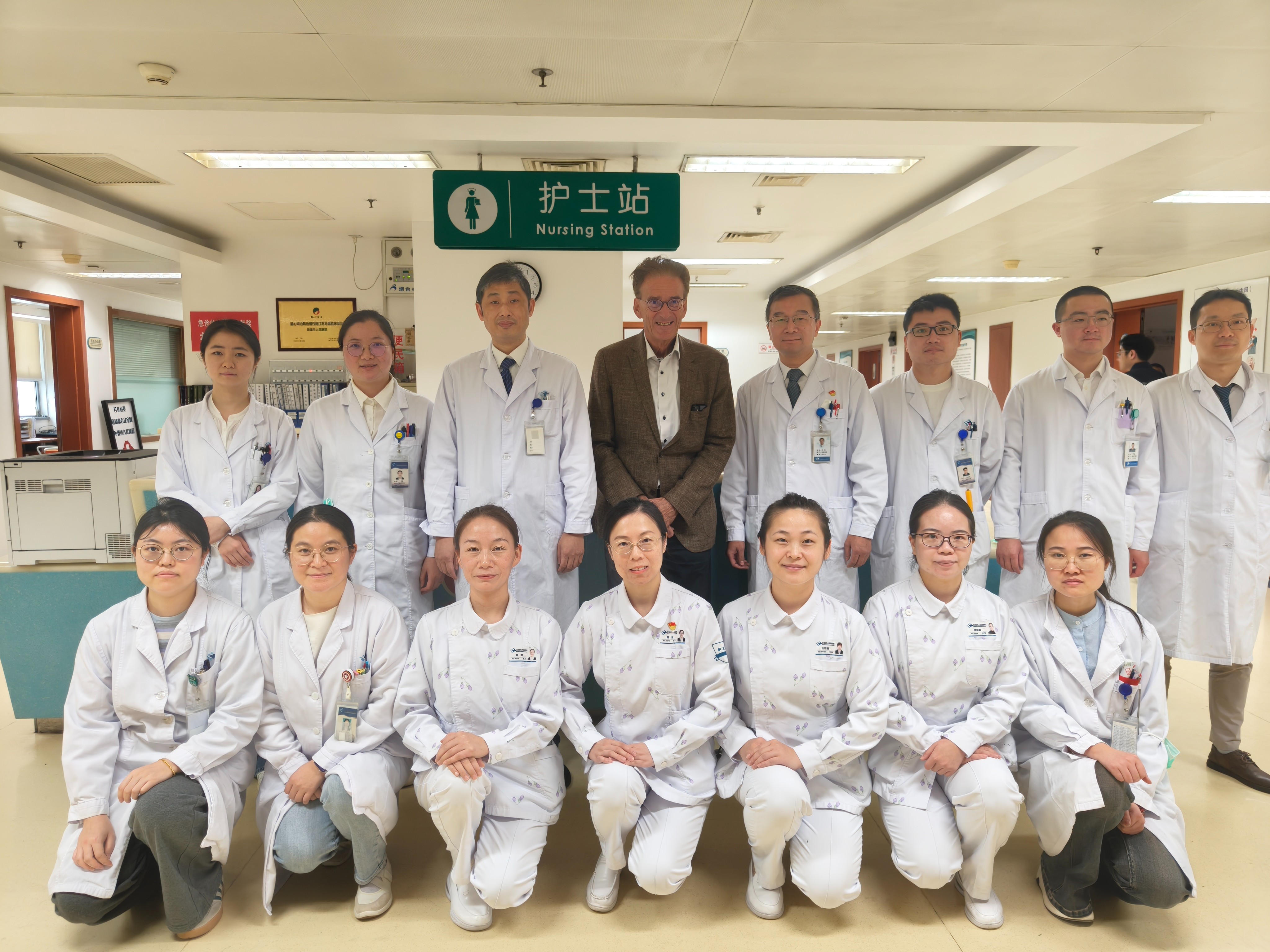
Special Lecture on Functional Neuroanatomy
On the afternoon of October 21, Prof. Bähr gave an internal lecture on the theme of "Functional Neuroanatomy." Prof. Bähr’s edited book Topical Diagnosis in Neurology: Anatomy, Physiology, Signs, Symptoms has gone through 11 editions and been translated into more than 14 languages, making it an essential reference book for neurologists. Prof. Bähr believes that localizing lesions based on clinical symptoms from physical examinations is the most important basic skill for neurologists, which can avoid unnecessary and expensive imaging examinations and save more time for patients. With abundant cases, Prof. Bähr elaborated on how to qualitatively and locally locate lesions through accurate medical history and precise clinical physical examinations, covering the motor system, brainstem, higher cortical functions, and limbic system.
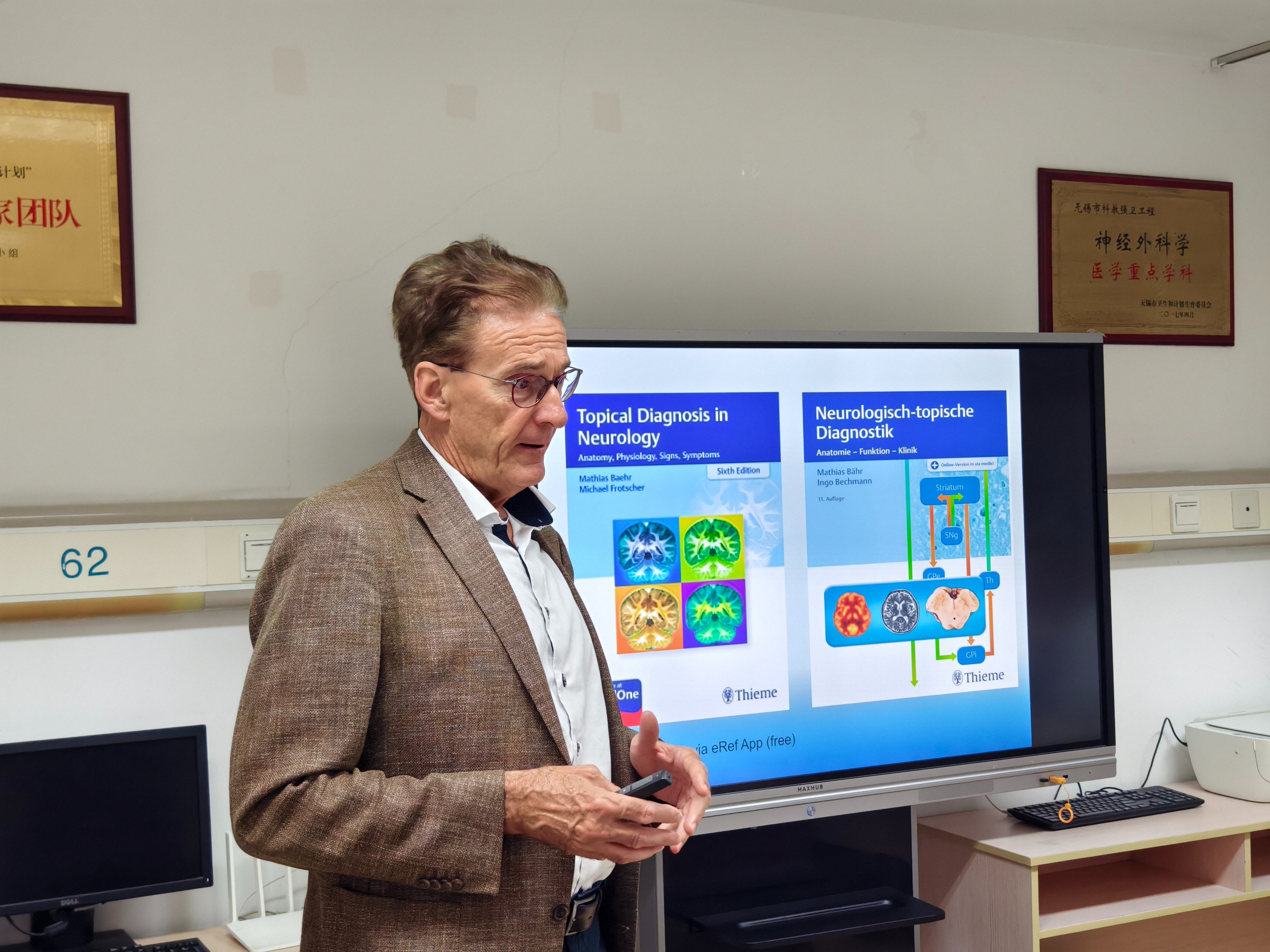
After the lecture, the doctors discussed medical images of difficult cases with Prof. Bähr, including multiple complex cases such as Neuronal Intranuclear Inclusion Disease (NIID), Reversible Posterior Leukoencephalopathy Syndrome (RPLS), increased intracranial pressure caused by arachnoid granulations, and Neuromyelitis Optica Spectrum Disorder with Initial Clinical Manifestation of Cognitive Impairment. The session was marked by a highly stimulating atmosphere of academic discussion and exchange.

Doctors participating in the exchange said they benefited greatly from this in-depth discussion. Prof. Bähr also mentioned that if they encounter difficult cases in the future, they are welcome to discuss with him at any time to continuously deepen academic exchange and cooperation between China and Germany and jointly promote the progress and development of the specialty.
Outpatient Consultation
On the morning of October 22, Prof. Bähr had a joint outpatient consultation at the Neurological Diagnosis and Treatment Center. The team of the department had prepared several key difficult cases in advance, focusing on the discussion of patients with Parkinson’s disease and related disorders. During the diagnosis and treatment, Prof. Bähr conducted detailed physical examinations, formulated personalized plans for patients with different conditions, which were precise and targeted. After fully understanding the patients’ conditions and completing the physical examinations, Prof. Bähr further improved the current diagnosis and treatment plans for the patients, and systematically promoted the implementation of personalized treatment through precise methods such as medication adjustment, dosage optimization, and special monitoring.

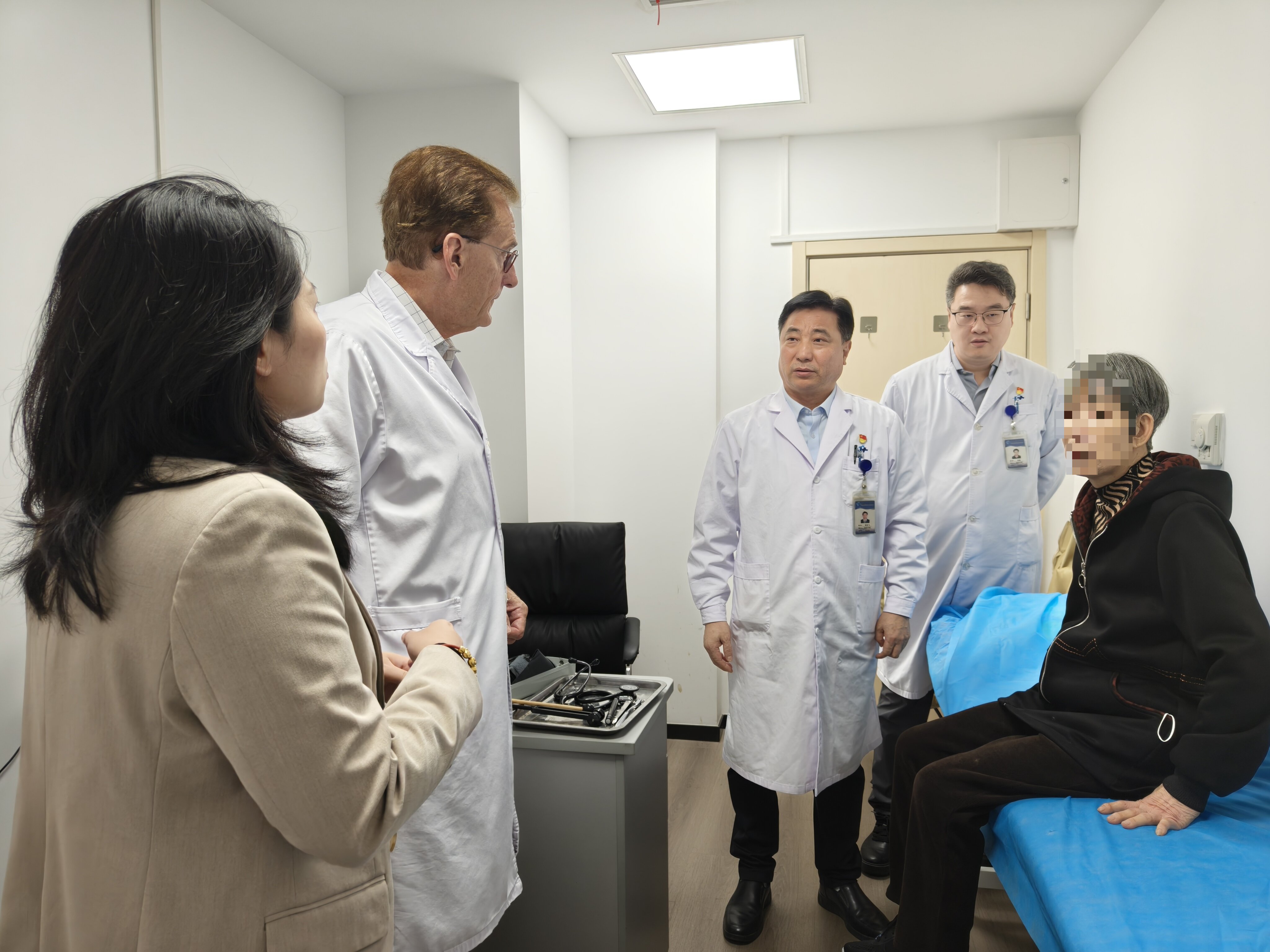
In addition, in the expert outpatient clinic, Prof. Bähr also handled difficult cases such as suspected epileptic seizures, trigeminal neuralgia combined with Parkinson’s disease, and cases requiring exclusion of central nervous system lymphoma. It comprehensively presented a systematic clinical approach, spanning from precise medication adjustment and surgical indication evaluation to differential diagnosis, thereby establishing a clear direction for the patient's subsequent treatment.
Keynote Lecture on Parkinson’s Disease
On the afternoon of October 22, Prof. Bähr held discussions on difficult cases with the team of the Neurological Diagnosis and Treatment Center, focusing on difficult movement disorders and in-depth discussions on issues such as the optimal target selection for Deep Brain Stimulation (DBS) surgery in patients with dyskinesia. At the same time, a follow-up evaluation was conducted on the previously discussed patient with cerebral venous sinus thrombosis, and Prof. Bähr gave specific guidance on subsequent treatment based on the patient’s condition.

After the case discussion, Prof. Bähr gave an internal lecture on the theme of "The Pathophysiological Role of Synuclein Antibodies in Parkinson's disease," covering core points such as the clinical symptoms and typical pathological features of Parkinson’s disease, Parkinson’s disease caused by gene mutations, and new treatment concepts. Prof. Bähr’s lecture triggered a lively interactive discussion on site, greatly benefiting all participating doctors.

Today’s exchange activities, through the multi-dimensional linkage of outpatient consultation, case discussions, and keynote lectures, further deepened the exchange of clinical experience and scientific research cooperation between Chinese and foreign experts in the field of neurology, laying a more solid foundation for jointly improving the diagnosis and treatment level of neurological diseases and better serving patients.
Inauguration Ceremony of the "Sino-German Exchange Center for Neurological Disease Diagnosis and Treatment"
On the morning of October 23, the team of the Neurological Diagnosis and Treatment Center reported and discussed two difficult cases with Prof. Bähr. The first case was thrombectomy for acute large vessel occlusion stroke. Both parties conducted in-depth exchanges on key issues such as the choice between bridging therapy or direct thrombectomy beyond the time window, the application of aspiration and stent techniques, the use of tirofiban in this patient group, and how to further optimize the green channel of the stroke center.

The second case was a venous thrombolysis case of mild young stroke beyond 4.5 hours. Discussions focused on the efficacy and safety of low-dose thrombolysis within this time window, the selection strategy of thrombolytic drugs, the support of imaging evaluation for treatment decisions, and the guiding significance of the frequency of NIHSS scoring during thrombolysis for treatment.
After the case discussion, Prof. Bähr went to the ward for teaching rounds and gave suggestions on subsequent diagnosis and treatment plans based on the specific conditions of the patients.

In the afternoon, the inauguration ceremony of the "Sino-German Exchange Center for Neurological Disease Diagnosis and Treatment" and the keynote lecture on specialty construction were held in the meeting room of the hospital’s History Museum. The event was moderated by GU Xiaofeng, Deputy Party Secretary and President of the hospital, and Party Secretary GAO Yufeng delivered a welcome speech. Subsequently, President GU Xiaofeng awarded Prof. Bähr the appointment letter as an international visiting professor, and the team of the hospital and Prof. Bähr jointly inaugurated the "Sino-German Exchange Center for Neurological Disease Diagnosis and Treatment."

After the inauguration ceremony, Prof. Bähr gave a keynote lecture on specialty construction, systematically sharing the practical experience of the University Medical Center of Göttingen in the development of the Department of Neurology and the Heart and Brain Center Göttingen. He introduced the overall situation of the center’s integrated development of teaching, scientific research, and clinical practice from the aspects of organizational structure, talent training system, and research directions. As a "science city" with profound scientific research heritage, Göttingen has not only nurtured 45 Nobel Prize winners but also gathered many top national research institutions such as the Max Planck Institutes, the German Center for Cardiovascular Research, and the German Center for Neurodegenerative Diseases, forming a highly concentrated and collaborative innovative core scientific research ecosystem.

On the fourth day of Prof. Bähr’s visit, through activities such as case discussions, clinical ward rounds, the inauguration of international cooperation, and specialty construction lectures, it not only achieved in-depth exchanges of diagnosis and treatment ideas for difficult cases and clinical practice guidance but also established the "Sino-German Exchange Center for Neurological Disease Diagnosis and Treatment" as an international cooperation platform. At the same time, it introduced the specialty development experience of Germany’s top medical centers. This event not only injected internationally advanced concepts into the Neurological Diagnosis and Treatment Center of Wuxi People's Hospital but also built a bridge for Sino-German academic exchanges in neurology, laying an important foundation for improving the level of clinical diagnosis and treatment, promoting the integrated development of scientific research and teaching in the future.
Scientific Research Project Report
October 24 was the last day of Prof. Bähr’s visit to the Neurological Diagnosis and Treatment Center of Wuxi People's Hospital. The whole day focused on two core sessions: scientific research project report seminars and keynote lecture, drawing a successful conclusion to the visit.
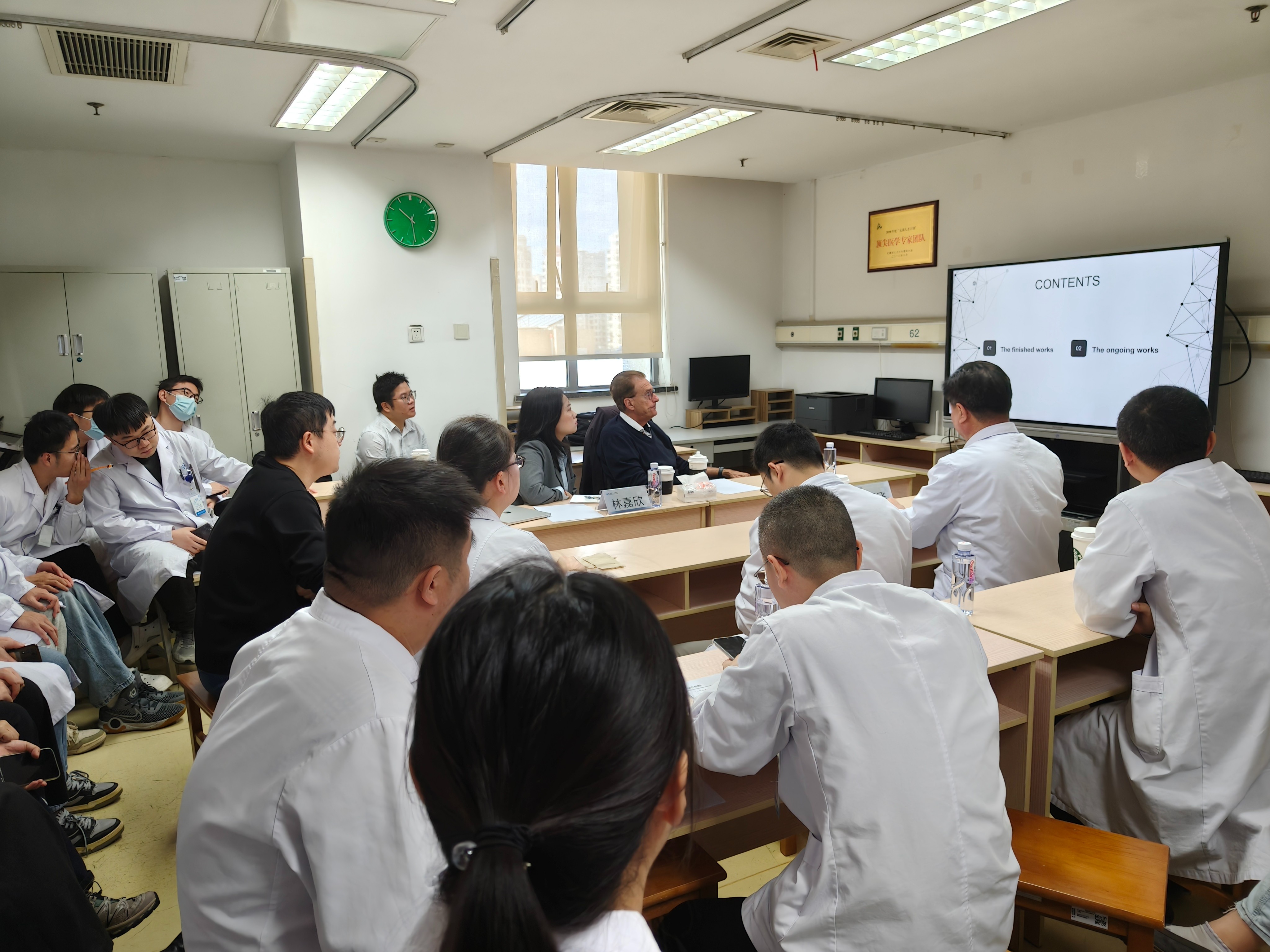
In the morning, researchers from the hospital’s Neurological Diagnosis and Treatment Center reported their research projects to Prof. Bähr, including "Reactive Astrocyte-Derived Neuritin Ameliorates Neurite Recovery After Ischemic Stroke via RBM3-Mediated Gene Regulatory Programs," "Association of Microplastics in Human Cerebrospinal Fluid and Alzheimer’s Disease-Related Changes," "Mechanism of the EBF3/UBRS/PHB2 Signaling Pathway in Regulating Astrocytic A1-Type Polarization Via Mitophagy in Epileptic Seizures," and "Persistent Posttraumatic Headache After Mild Traumatic Brain Injury—The Influences of Alcohol, Tobacco, and Sex Differences."

Prof. Bähr showed great interest in the research projects, not only conducting in-depth discussions with young doctors on the details of the projects but also putting forward targeted suggestions for subsequent research adjustments. He highly affirmed the scientific research strength of the center, saying that "these studies completed by a group of doctors who are primarily engaged in clinical work are very impressive." At the same time, he shared the ongoing research projects of the University Medical Center of Göttingen in fields such as stroke, Parkinson’s disease, Alzheimer’s disease, prion diseases, and neuromuscular diseases, providing the team of the hospital with scientific research ideas from an international perspective.
Special Lecture on Alzheimer's Disease
In the afternoon, Prof. Bähr gave a keynote lecture on the theme of "Current Status and Prospects of Alzheimer’s Disease," covering core content such as the pathophysiological mechanism of Alzheimer’s disease, disease-related biomarkers and the development of early disease biomarkers, the AT(N)C classification system for Alzheimer’s disease diagnosis based on biomarkers, the application and limitations of existing monoclonal antibodies for Alzheimer’s disease, new drug development directions, and gene therapy directions for Alzheimer’s disease. After the lecture, participating doctors actively raised questions and held enthusiastic interactions with Prof. Bähr, further deepening their understanding of the knowledge.
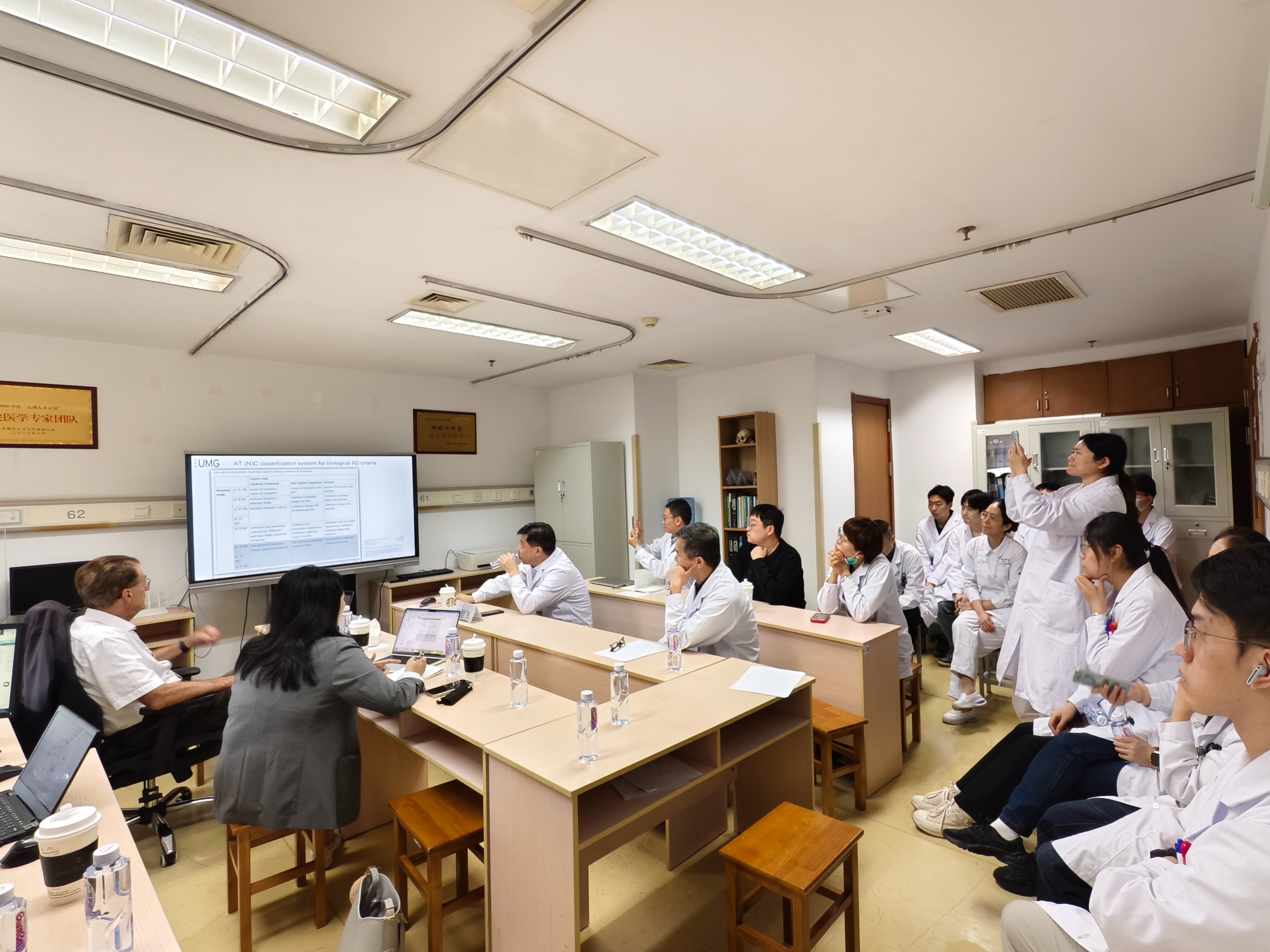
Thus, the academic exchange activity of Prof. Bähr’s visit to Wuxi People's Hospital officially concluded. Prof. Bähr expressed sincere gratitude for the warm reception throughout the visit and mentioned that this trip to Wuxi gave him a more intuitive and in-depth understanding of the model, diagnosis and treatment characteristics of Chinese hospitals, as well as Chinese culture. This cross-border academic interaction not only enabled the Neurological Diagnosis and Treatment Center of Wuxi People's Hospital to accurately introduce internationally cutting-edge diagnosis and treatment ideas and scientific research directions but also successfully built a long-term dialogue and cooperation bridge for Sino-German neurology. It laid a solid foundation for the hospital to further improve the precision of clinical diagnosis and treatment of neurological diseases, promote the in-depth integration of scientific research and teaching, and build an international discipline development ecosystem.

